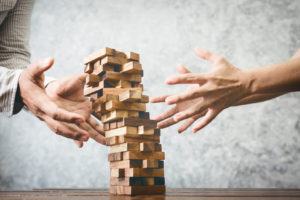Is Yet Another “Exercise” Really What You Need?
“I just need a few exercises I can do at home that will help me fix this.” I can’t tell you how often I hear those words. I’ve said them myself. I get it. You’re fit. You’re smart. You’re disciplined. You’re used to handling things on your own. So when you’re faced with a movement challenge or pain issue, you might seek help for a diagnosis of the problem. But after that? All you really want is a few key exercises that will help solve whatever the problem is. Working on your own is less expensive, and it fits into your schedule better, right? The trouble is that pain and movement problems often require a re-education of body and mind, not just an exercise.
Throwing existing knowledge and muscle patterns at a persistent movement or pain problem is not always the best strategy; even when you have a few new exercises to try. The answer often lies in learning new things about your body and how it moves. Or in gaining a new awareness of compensations, patterns and habits in your movement that may be the root of the problem. Those things are not easy to perceive from the inside out! Non-optimal movement patterning often feels “normal,” if you’ve been doing it long enough. It’s HOW you do what you do that makes all the difference in the world. As you build awareness, having some support in deconstructing the problem, identifying drivers of dysfunction, understanding your habits and patterns around specific movements, and learning how to load them and when, can go a long way toward creating lasting change.
 Just about everyone has movement patterns that would benefit from support and coaching. Over time, we all create compensations that serve some kind of purpose. Our bodies are so wonderfully adaptable! Athletes especially, though fit and generally healthy, are MASTER compensators; devising all kinds of creative workarounds to get the job done. Things may go relatively well when the body has enough adaptive range to accept those compensations. Efficiency and coordination will likely suffer to some degree. But when the adaptive range runs out, it’s more effortful to move, and injuries start to happen. Education around that dysfunction or injury involves unraveling the compensations and building in more optimal patterning. As a result, movement feels easier and more relaxed. You’re creating a more resilient, supported and pain-free body!
Just about everyone has movement patterns that would benefit from support and coaching. Over time, we all create compensations that serve some kind of purpose. Our bodies are so wonderfully adaptable! Athletes especially, though fit and generally healthy, are MASTER compensators; devising all kinds of creative workarounds to get the job done. Things may go relatively well when the body has enough adaptive range to accept those compensations. Efficiency and coordination will likely suffer to some degree. But when the adaptive range runs out, it’s more effortful to move, and injuries start to happen. Education around that dysfunction or injury involves unraveling the compensations and building in more optimal patterning. As a result, movement feels easier and more relaxed. You’re creating a more resilient, supported and pain-free body!
Here are five things that “a few exercises” won’t do for you:
- Make sure you’re recruiting optimal patterning for movement
Back pain, hip dysfunction, core issues – each of these problems has a multitude of protocol based exercises that are recommended. My question to you is this: are you actually recruiting the muscles you think you’re recruiting as you do the exercise, or are you activating your own well-programmed personal compensations? How will you know? Our brains drive movement through the use of neuromuscular patterns, which are like well-traveled trails between brain and body. The more often we use a particular pathway, the more likely the brain is to choose that pathway for movement going forward. In a best case scenario, these patterns allow for spontaneous, fluid and efficient movement. If somewhere along the line a particular pattern has become corrupted by non-optimal compensation, then that corrupted pathway may inappropriately load structures and tissues around it. Your own sensory map of your body may be acting like a faulty GPS – leading you confidently down the wrong path! No matter how fabulous the exercise, if the patterning is faulty, you may simply be building more creative compensation leading to dysfunction, reduced mobility and potential injury. Having an outside eye can help you feel your way to a new normal, and better results.
- Identify whether a muscle is inhibited or weak Nothing in your body works in isolation. Everything has some kind of a relationship to everything else. When you experience a persistent weakness, despite your best attempts to gain some strength in that area, there is likely something else going on. A example of this is a common dysfunction in “the core.” Occasionally, people find they just can’t recruit their abdominal muscles they way they’d like. It’s not unusual for the deep layer of the abdominal wall to be inhibited by an over-activation of other structures – like a grippy butt or ribs. In some cases, this looks like a belly bloat that you just can’t tuck in. You can throw all the abdominal work you want at that belly – but because overactive structures are creating too much intra-abodominal pressure, you likely won’t be able to activate that deep abdominal wall. Some help in understanding when a muscle is inhibited, and not just weak, can go a long way toward ending the sense of struggle in trying to make it happen, when it just can’t!
- Determine whether release or strength training is more appropriate
We’re not used to letting go, but sometimes that’s exactly what we need! Initially, that release may come in the form of a relaxing stretch, or some breathing, or even a specific release technique. Eventually though, you have to figure out how to carry that release, and a more balanced effort, into your movement – whether that’s walking around the house, running a marathon, playing tennis or lifting weights. Finding and maintaining that balance is facilitated by an integrated core. When you find that balance – the result is ease and flow (which translates to improved stamina, a feeling of increased strength & agility, and better times). In our culture, we’re programmed to believe that more is better: more effort, more repetitions, more work. It can be hard to believe that in some things, less is definitely more. - Determine when stability training is the priority
Maybe you’re a runner, or a cyclist. And maybe your day job involves sitting at a desk. You’ve stretched, and stretched, and stretched those hips… but they’re tight again in a blink of an eye. What the heck? Know that there is a logic behind your body’s choices. If you’re consistently tight in the hips, there’s likely a perfectly good reason for it. Part of that reason will be the patterns created by activities you do often. Running, cycling, and sitting involve a lot of hip flexion. The repetitive flexion may be to blame. But you may also be dealing with the fact that your lumbar spine is not well supported. When the brain perceives a vulnerability in the structure, it will find other ways to create some semblance of stability. Tight hips is one way to do it. The solution may lie in improving stability in the spine… not in continually stretching the hips. If you find yourself getting tighter and tighter, and your overall mobility is suffering – you have a stability problem. Not a stretch problem. Get some help figuring out where that stability is most needed.  Evaluate the integrity of your entire structure
Evaluate the integrity of your entire structure
Sure, you know how to get ‘er done! But can you tell when your structure is managing the load effectively, or when you’ve overloaded into compensation? If you’re constantly working to the max, you may be creating a sympathetic stress on the system that delivers diminishing returns. You want to load enough to make gains in strength and stamina, while respecting the capacity of the whole structure. Too much load, too often, can cost you – at first in terms of compensations and inefficiencies, and later, in the form of dysfunction or injury. Explore the sensations in your own system that tell you when you’ve taken it too far for your own best results. Breathing, effort level, structural awareness, rest – these are all things that an experienced outside eye can help you learn to translate to more consistent, sustainable training (and a happier body) over the long haul.
So, if yet another exercise is really what you need – then by all means go for it.
Sometimes that IS the best solution. Be mindful as you work to get the most out of it. But if what you’re looking for is real and sustainable change in how your body feels and moves, consider a more comprehensive approach. Your current knowledge and experience have served you well in getting you to where you are now. But that same knowledge and experience may not take you to the next level. New input, new information, expert guidance and frequent, quality practice can offer you stunning new possibilities.
With that in mind, I’d like to present you with a gentle challenge, on your behalf.
Instead of tolerating dysfunction because you don’t have time, or chalking those aches and pains up to old age – choose to do something different. Expand your view of what “fitness” looks like. And if moving with easel is valuable to you, choose movement over muscle. Make a choice between training “exercise,” or working to gain real-time body knowledge as you improve stamina, strength and mobility. The choices you make now will have an impact on your overall comfort and physical health. And they’ll improve your mobility now, and as you age. Take a stand for your own movement, for your own fitness, for your own health. Oh, the places you’ll go!!
When you’re ready, Moving Spirit can help. Check out our Getting Started Guide for more information about our programs, or book an Introductory Private Training Program today.
About Susannah Steers
 Susannah is a Pilates and Integrated Movement Specialist, and owner of Moving Spirit. Through movement teaching, speaking and facilitating workshops, she supports people in creating movement practices that support fitness from the inside out. Susannah co-hosts the Small Conversations for a Better World Podcast; an interview-style podcast dedicated to promoting conversations about health that can spark positive change in individuals, families, communities and across the globe.
Susannah is a Pilates and Integrated Movement Specialist, and owner of Moving Spirit. Through movement teaching, speaking and facilitating workshops, she supports people in creating movement practices that support fitness from the inside out. Susannah co-hosts the Small Conversations for a Better World Podcast; an interview-style podcast dedicated to promoting conversations about health that can spark positive change in individuals, families, communities and across the globe.
